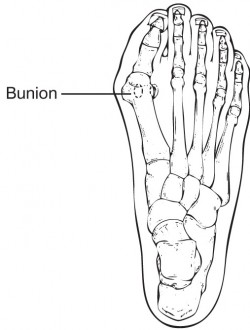A bunion is formed when the big toe drifts towards the second toe which causes a bump to form on the inside of your foot at the base of the big toe. Patients will often notice that the bunion often worsens with time.
Common Symptoms
-
Pain while walking
-
Joint pain and stiffness
-
Irritation over the bump
-
Shifting of the big toe
We take x-rays to evaluate your bunion severity and grade it: mild, moderate, or severe. Often inserts or orthotics along with padding are helpful for immediate pain relief. We will also give you a recommendation on shoes that prevent aggravating the condition. If conservative treatments are exhausted, surgery may be needed.
Bunion Surgery
There are many different types of procedures used for bunion correction. There are procedures that allow you to start walking after surgery. Some procedures are used to correct a more severe bunion deformity that require crutches for several weeks.
Types of Bunion Surgery
-
Head procedures (around the big toe joint)
-
Base procedures (at the joint behind the big toe joint)
Head procedures are for the correction of a mild to moderate bunion deformity. The recovery time is quicker and patients can put weight on the surgical foot.
Base procedures are for a moderate to severe bunion deformity. Recovery requires patients to use crutches and to keep weight off of the surgical foot for 4-6 weeks.
There is large amount of medical research showing which bunion procedures are most effective in specific situations. At Greater Houston Foot & Ankle Specialists, we perform an examination of your lower leg and foot, review your biomechanics and x-rays, and give you a complete explanation of what choices you have, including what type of procedure we recommend.
To have your bunion evaluated, make an appointment with Greater Houston Foot & Ankle Specialists.
Dr. Stephen Moore and Dr. Gkotsoulias are podiatrists serving
The Woodlands, Kingwood, Spring, and Tomball areas.

